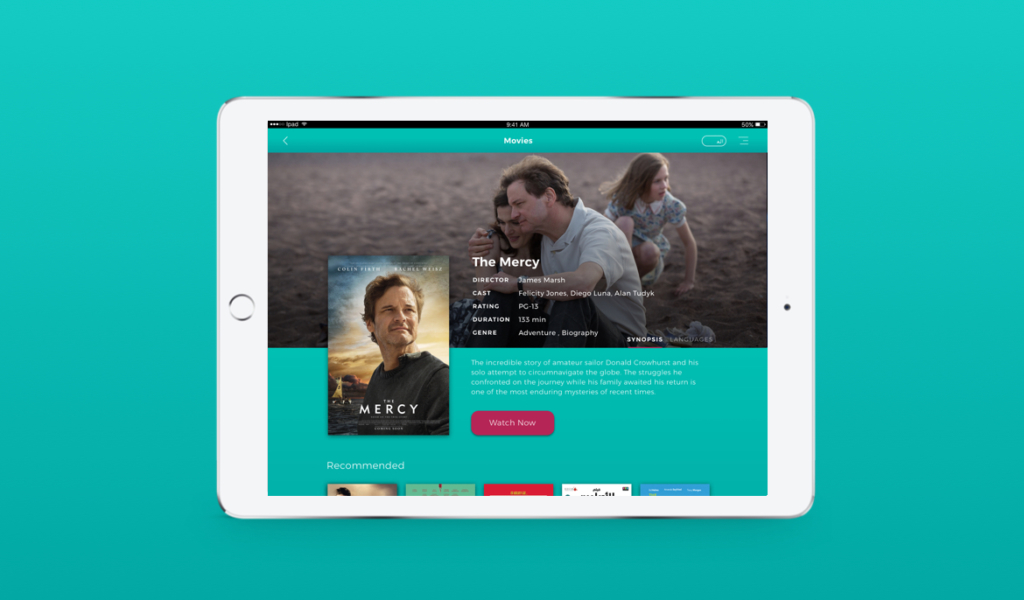“We’re thrilled to partner with Inflight Dublin on this exciting wireless IFE journey. IFE adds to the great value offering onboard flynas flights and will be a key part of our superior customer offering,” says Asma Talal Hamdan, Chief Information Officer at flynas. “All the latest content, combined with the seamless technological aspects of the solution, supports our ability to provide unique travel experiences with incomparable value additions, digitized solutions and enriched on board experiences.”
Tag: content
Book-to-Movie Adaptations: Tricky Waters to Navigate
Regardless of potentially polarizing reactions, some of the greatest movies of all time have been based on or drawn influence from books – The Shawshank Redemption, The Lord of the Rings, Apocalypse Now, and The Shining to name a few. A who’s who of iconic filmmakers have rolled the dice and successfully adapted these winding narratives into condensed and satisfying cinematic experiences, often taking risky creative liberties to make the most impactful films possible.
This month on the IFD Podcast, two of our in-house bookworms, Aoife and Eimear, take a look at a few of their favourite book-to-movie adaptations, exploring the history of the titles and drawing comparisons between the different mediums.
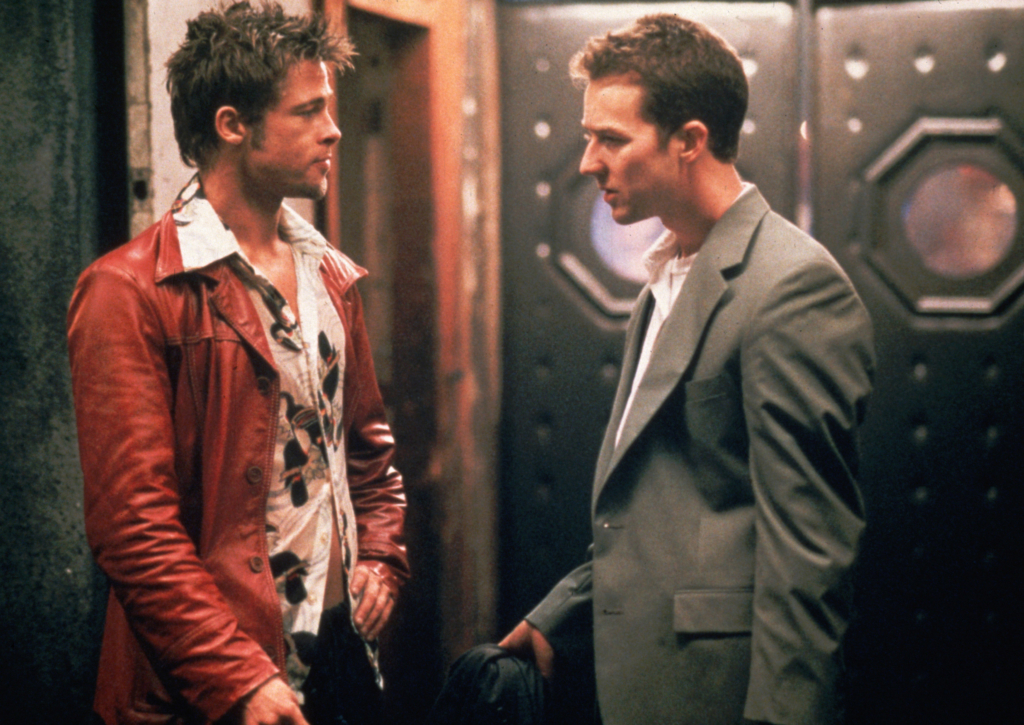
Artwork © 1999 Twentieth Century Fox Film Corporation. All rights reserved.
First up on Aoife’s list is David Fincher’s 1999 classic, Fight Club. Based on the novel of the same name, written by Chuck Palahniuk and released just 3 years prior to its visual counterpart, Fight Club has been labelled as a “coming of age film” by Fincher. The movie amassed a loyal cult following in the years after its release, featuring strong performances from Brad Pitt, Helena Bonham Carter, and Edward Norton, along with one of the most memorable endings in recent memory. Aoife explains that while it took heavy influence from the source material, the movie arguably rescued the book from eventually fading into obscurity.
“his characters feel confined by societal norms”
Aoife O'Neill Gormley
Aoife’s second choice was Spike Jonze’s adaptation of the iconic 1963 children’s picture book, Where The Wild Things Are. An unconventional movie with an atmosphere that can be difficult to define, it perfectly reflects the surreal nature of Maurice Sendak’s original illustrations while simultaneously managing to feel like its own entirely unique experience. Aoife discusses the challenges facing a director when handling such a treasured work.
Eimear decided to hone in on some classics from the high school teen movies of the 90s, taking 1995’s Clueless as her first point of discussion. Loosely based on Jane Austen’s 1815 novel Emma, Eimear discusses how the film reappropriates the setting, characters, and themes to resonate with a modern audience, but maintains strong parallels to the novel with regard to its narrative structure, and how Amy Heckerling’s clever reimagining of the material ushered in an entirely new sub-genre of classic texts framed through a contemporary lens.
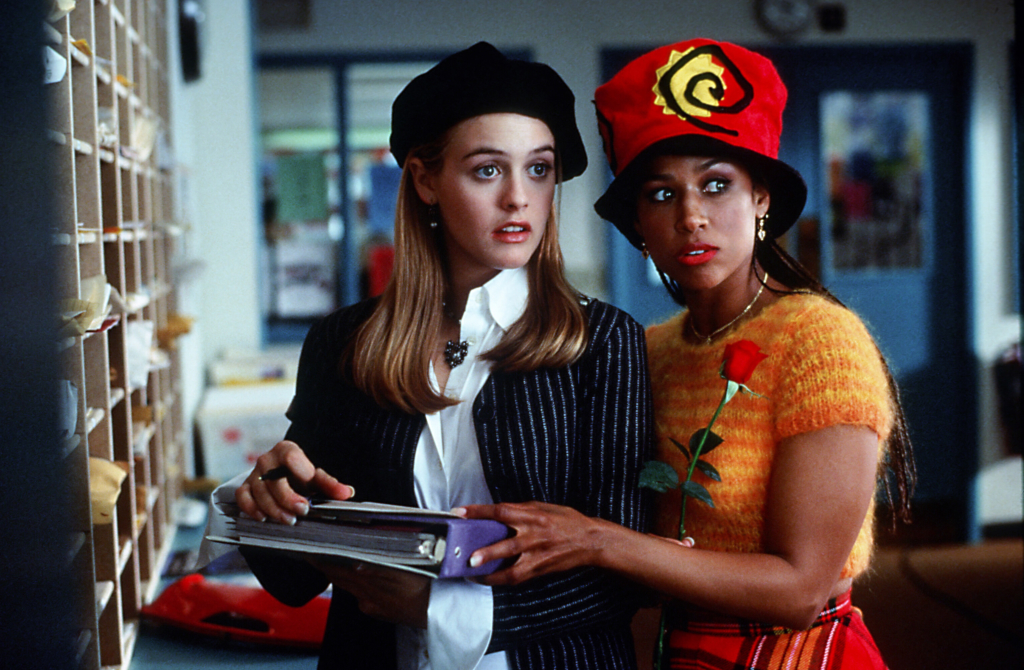
TM & Copyright © 2019 by Paramount Pictures. All rights reserved.
Next up on Eimear’s list was Gil Junger’s 1999 rom-com 10 Things I Hate About You. A loose modernization of Shakespeare’s The Taming of the Shrew, the film abides by Eimear’s case for the 90s-era obsession with recontextualizing older writings to create compelling modern stories. It acted as a springboard to success for a number of young actors, providing breakthrough roles for Julia Stiles, Joseph Gordon-Levitt, and Heath Ledger.
“the spirit of Emma’s character is carried over to a new audience”
Eimear O'Donoghue
Are you a book-purist that believes treasured material should be left untouched? Or do you welcome films based on your favourite books with open arms? We’d love to know what you consider to be some of the best adaptations we’ve seen to date, or what books you’d like to see on the big screen in the future!
Inflight Dublin sponsor APEX Market's Networking Event in Dublin
Inflight Dublin was delighted to sponsor Apex MultiMedia Market’s Networking Event which took place on the evening of Tuesday 16th April between 19:30 – 22:30 at the Ely Wine Cellar in the IFSC.

The Airline Passenger Experience Association (APEX) is the only non-profit membership trade organization comprised of the world’s leading airlines, industry suppliers, major media groups and related aviation industry leaders dedicated to elevating the passenger experience for more than 80% of global passengers while driving industry initiatives and desired regulation.
The association offers members a wide range of opportunities to excel in the airline passenger experience industry by keeping them current with the latest industry news, trends and developments and by helping them develop relationships with clients and colleagues from around the world.
APEX MultiMedia Market’s Networking event is a chance for airlines and service providers to meet with distributors offering a range of new and acclaimed TV, movie, games, app and audio content options. It is an invaluable experience to discuss current IFE content trends with top distributors from across the globe.
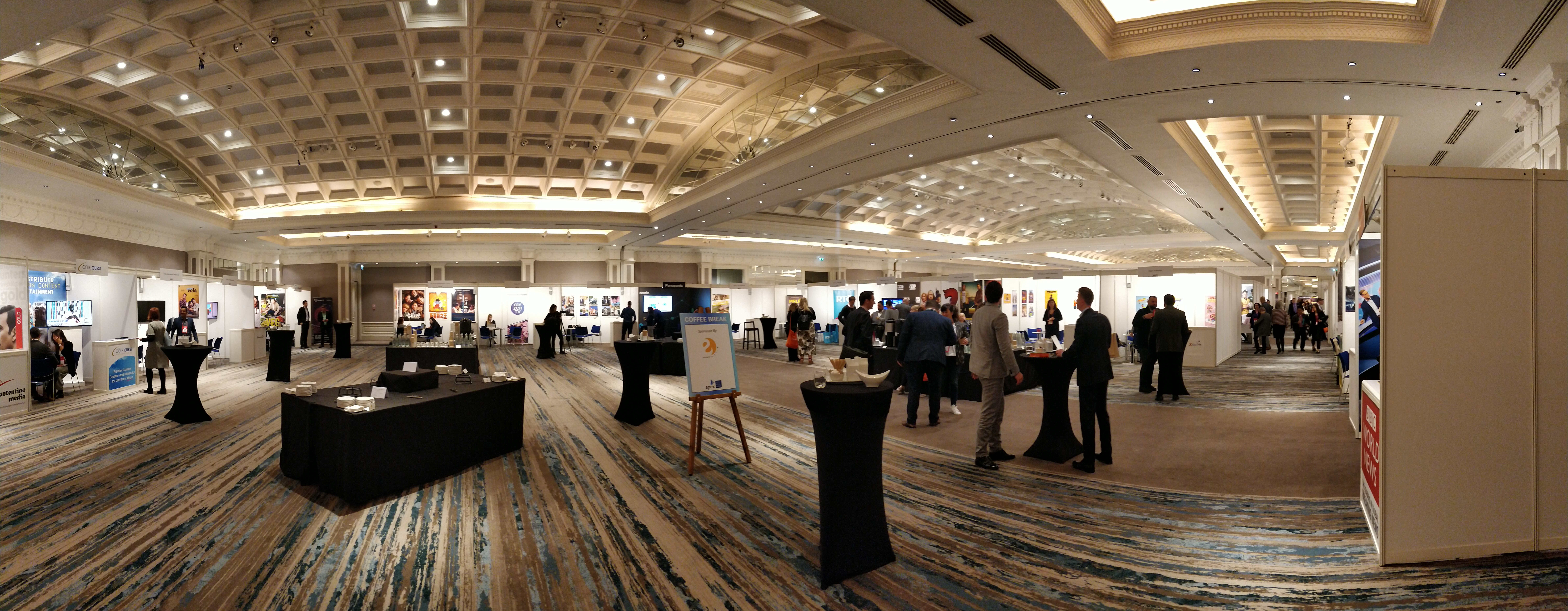
In addition to attending the APEX Multimedia Market, Inflight Dublin annually exhibits at the APEX Expo, which this year is taking place in Los Angeles from the 9-12 September. Our team of IFE specialists will be on site at the Inflight Dublin Booth 1307 to meet with both our existing airline partners and prospective airlines, showcasing first hand our full range of IFE products and services.
If you wish to schedule a meeting with one of the team attending the Expo, contact us via email on: mail@inflightdublin.com
Irish Film: Fan Favourites
“One that really stood out to me, which I would have seen when I was about 15, was Breakfast on Pluto.”
Eimear chose the comedy-drama Breakfast on Pluto as her favourite, which came out in 2005 and is based on the novel by the same name by Patrick McCabe, of Butcher Boy fame.
“It’s directed by Neil Jordan who also did The Butcher Boy and The Crying Game. Very well respected Irish director.”
Starring Cillian Murphy as the lead, a transgender woman who was abandoned at birth and grows up in a small town in rural Ireland in the 1940’s.
“They get the essence of Patrick ‘Kitten’ Braden, who’s the main character, played by Cillian Murphy in the film.”
Cillian Murphy is famed for many roles, notably as the Scarecrow in The Dark Knight trilogy, but he also played lead roles in other famous Irish films, such as Intermission and The Wind That Shakes the Barley.
“Basically it’s split into about 36 chapters. So it’s a kind of, picaresque film, where it’s just following Patrick Kitten Braden through his life.”
From her upbringing in an uncaring foster home, to running away from home with a glam rock band and getting involved with the IRA, it’s a tumultuous existence Kitty lives, and yet she does it with complete poise.
“It’s sort of Dickensian in the way that his spirit triumphs throughout.”
Featuring a whole host of stars, some of rest of the cast include Liam Neeson, Ruth Negga, Liam Cunningham and Stephen Rea.
“I’d say the best cameo in it has to be Brendan Gleeson as a Womble.”
An award winning film, Breakfast on Pluto secured four Irish Film and Television Awards and earned Cillian Murphy a Golden Globe for Best Actor.
“I’m glad I re-watched it! And the costuming is incredible.”
Aoife, who if you’ve been listening you know loves all things horror, chose the recently released The Hole in the Ground. Released at the start of March of this year, The Hole in the Ground is a horror thriller that had its world premiere at the Sundance Film Festival in January.
“It’s starring Seána Kerslake who was also in A Date for Mad Mary which I also absolutely loved. It was just such a fun movie, but this is a very different vibe.”
Seána Kerslake (pronounced Shaw-nah) is also well known for being one of the leading roles in the Irish television show, Can’t Cope, Won’t Cope. She is definitely a star on the rise in the film industry.
“It’s an interesting film because, you know we get a lot of these horror movies where these mothers are stuck in their houses and they become afraid of their children.”
A mother flees a possibly abusive relationship with her young son to the Irish countryside and settles down in a house next to a forest, where a large sinkhole sits in the centre.
“What would you do if you found out your child was becoming someone you didn’t like?”
The film draw on themes of doppelgängers and changelings, with changelings being heavily featured in Irish folklore as a cruel trick played by faeries, and doppelgängers originating from Germany and representing extreme bad luck.
“I think that Irish horror in general is having a little bit of a moment.”
Some of the more popular Irish horror films that have come out in the last decade and that we highly recommend are The Hallow, The Lodgers and The Canal. If you’re a horror fan they are definitely worth a watch!
“I wanted to talk very briefly about Without Name. This is the eco-horror.”
Directed by Lorcan Finnegan and starring Alan McKenna, this film centres on a mysterious forest and a man with something to hide.
“Extra Ordinary is coming out as well which is sort of like a, comedy horror it looks like? With Maeve Higgins in it, I think she plays a driving instructor who can converse with the dead.”
Extra Ordinary had its world premiere in March at the SXSW Film Festival in the United States. Official release date is still to be announced but it is making waves in the festival circuit.
“I feel like the Irish have a good sense of a Gothic tale.”
As the birth place of Bram Stoker, Halloween and banshees, it’s safe to say the Irish know how to tell a good horror story.
That’s not to say they can’t tell an uplifting one from time to time either! Have a listen and leave a comment, do you have a favourite Irish film? Let us know!
Samantha Lyons | Inflight Dublin
A Review of the Golden Globes and an Intro to the Oscars
Our resident film nerds are back with another podcast! This time around, Aoife and Sam chat about the recent Golden Globe winners and Oscar nominees in a few of the big categories, ahead of the bumper podcast that will be coming your way at the beginning of March. “So Bohemian Rhapsody won the Golden Globe for Best Motion Picture/Drama and I thought that was kind of disappointing to be honest.”

Winner of Best Motion Picture – Drama in the Golden Globes and nominated for the Oscar for Best Motion Picture, Bohemian Rhapsody also has its star Rami Malek up for an Oscar for Best Actor after winning the Golden Globe. “I think it’s just one of those films where it baits the crowd. This is exactly what people want even though it’s not what happened.”
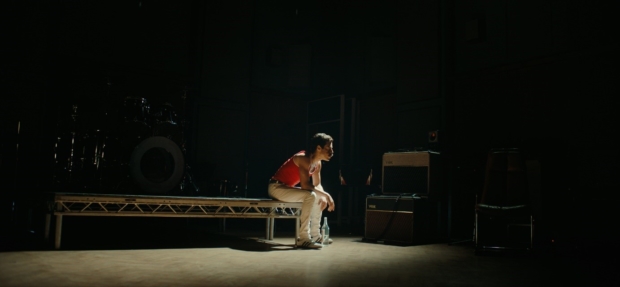
To say these two disagreed with some of the winners is an understatement so be prepared to hear a lot of opinions about who won and who they felt should have. “That’s what I was planning to do with A Star is Born, I was like, I don’t think I’m going to like this movie and people are going to hate me for not liking it. But someone said, no, you have to go see it! So I trusted that person and I did not love it.”

Some of the breakout hits of the year that captivated audiences and critics alike, such as A Star is Born, just did not hit the mark for these two. Nominated in four categories in the Golden Globes and snagging the win for Best Original Song with “Shallow”, this popular drama has been nominated for eight Oscars over all. “It would be a bit of a kick in the teeth for the other actresses who have been around for a long time for a singer to get an Oscar on her first try.”

That’s not to say they hated everything, two films got mentioned more than once as favourites by them; Roma and The Favourite. “She was really good, she just wasn’t outstanding. Unlike Yalitza Aparicio, she was the lead in Roma and she was just absolutely outstanding. She just blew me away.” Roma took home two Golden Globes, for Best Motion Picture – Foreign Language and Best Director respectively, and is also up for a grand total of ten Oscars, competing directly with The Favourite who is up for the same after Olivia Colman’s win at the Golden Globes.

We’d love to hear your opinions on the Golden Globes and don’t forget to check back next month for our take on the Oscars 2019!
Samantha Lyons | Inflight Dublin © 2018 Twentieth Century Fox Film Corporation. All rights reserved. © 2018 Warner Bros. Ent. All rights reserved.
The Favourite set to reign the BAFTA's
With five Golden Globe and twelve BAFTA nominations, as well as being the winner of two awards at the Venice International Film Festival, The Favourite has been causing waves with critics and audiences alike since its release. Queen Anne (Olivia Colman) is in bad health and sits on the throne, though she seems to have little interest in governing and more in pursuing her quirky interests. However, her trusted advisor and friend Duchess Sarah Churchill (Rachel Weisz) more than makes up for Anne’s lack of interest by directing and controlling the Queen’s choices and effectively running the country through her suggestions.

This delicate balance begins to tip when Abigail Hill (Emma Stone), Sarah’s impoverished cousin, arrives and starts to court the Queen’s desire for gentle affection, the type Sarah has not provided in a long time. These two women start to play the game against one another, though it soon becomes apparent that the position of a pawn on the board is not as clear cut as it initially seemed. After all, there can be only one Queen.

Starring Olivia Colman, Rachel Weisz, and Emma Stone, these three award-winning giants of cinema use their formidable talent to display the passions, desires, and hunger for power these three historical figures sought and sacrificed heavily for. Director Yorgos Lanthimos of The Lobster and The Killing of a Sacred Deer, also uses his skill of combining subtlety with vibrant essences to showcase this sumptuous dramatization of the life of one of the more enigmatic monarchs in British history.

With 12 nominations, along with its notable success at the Golden Globes, The Favourite and it’s stellar cast are all but set to occupy the throne at this years BAFTA Film Awards. Samantha Lyons | Inflight Dublin © 2018 Twentieth Century Fox Film Corporation. All rights reserved.
Early Window Content now available on Everhub!
The long-awaited news is here! As a leading IFE Content Service Provider (CSP), we are delighted to now offer Early Window Content to all of our wireless customers. Inflight Dublin has worked hard over the years to develop trusted relationships with all major Hollywood studios, and of course other top studios across the globe. This development now allows airlines using Inflight Dublin’s wireless Everhub solution to give their passengers access to Early Window Content via their personal device. This ensures that the same excellent selection of new movies and TV shows we provide for seatback VOD systems, are now available on our Everhub wireless IFE solution.
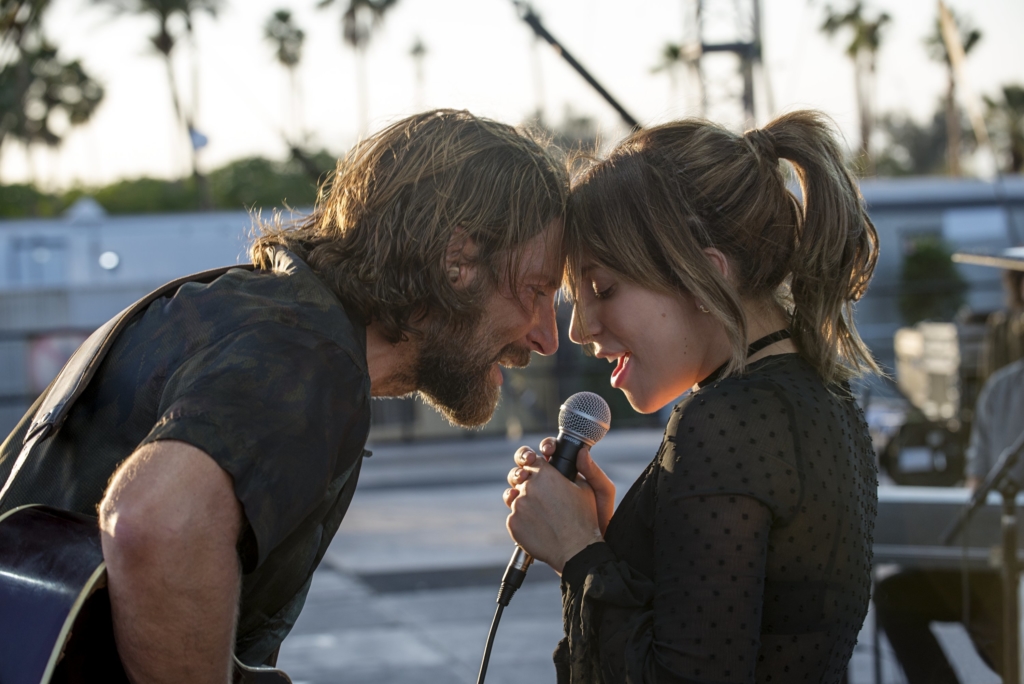
© 2018 Warner Bros. Ent. All rights reserved.
The advancement further enhances our market leading wireless IFE offering and supports our mission to bring the latest IFE to all airborne passengers. Everhub wireless IFE has already been approved for browser based DRM, removing the need for passengers to download specific applications prior to boarding. This reinforces Inflight Dublin’s position as the only true end-to-end wireless IFE provider – offering multiple hardware options, innovative software platforms, and a comprehensive in-house content library with countless titles available from across the globe.

© 2018 WBEI Publishing Rights © J.K.R. TM WBEI
Transform your passengers experience on board with Inflight Dublin.
Quality. Innovation. Value.
A24 and the Emergence of Post-Horror
A24 has established itself as a force to be reckoned with in the landscape of modern cinema, an unassuming production company and distributor whose ghostly arrival has garnered widespread critical acclaim, and even prestigious recognition from The Academy itself with Moonlight’s dark-horse victory over La La Land at the 2017 Academy Awards ceremony. The company has made a name for itself in the industry by releasing low-budget, critically successful indie films that may win awards, but don’t necessarily win over audiences.
In the past few years, an area which has prevailed as one of A24’s fortes is their ever-growing catalogue of unique indie horror films. Since the establishment of the literary horror genre, critics have been determined to define the content depending on the text (gothic, supernatural, fantastical, naturalistic, psychological, etc), and as the genre continues to develop, the discussion surrounding these definitions and their applicability has carried over into the world of film. Sitting atop the mountain of commercial and critical success for A24 is Ari Aster’s troublingly macabre masterpiece, the 2018 film Hereditary. One of the most critically acclaimed movies of the year, Hereditary has amassed an impressive 89% fresh rating on Rotten Tomatoes on top of its impressive box office intake. But a glaring discrepancy lies between the critics-to-audience reaction to the film.
Similarly to its’ A24 peers The Witch and It Comes at Night, the film failed to impress mainstream moviegoers generally and received a D+ grade on CinemaScore – a polling website which measures and rates audience viewing experiences in cinemas across America. What separates these films from their jump-scare riddled rivals, and is it feasible to fund more projects like Hereditary in future if audience reactions continue to dip so far below their critical counterparts? The term ‘post-horror’, coined by Steve Rose in his Guardian piece “How post-horror movies are taking over cinema”, has been used to define this current vogue subgenre of horror. But what does it mean, and where did it come from? Is it really a new genre or just a new way of presenting classic horror ideas? Three horror-fanatics, Aoife, Jamie, and Samantha, will discuss a number of topics related to this in an attempt to figure it all out!
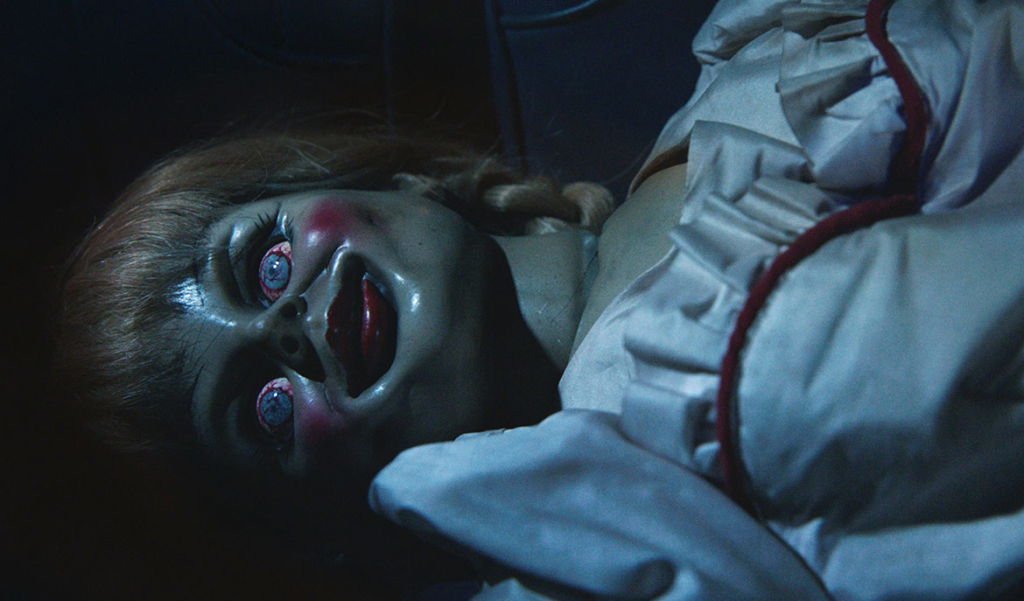
Sam: Have A24 created a new, better style of horror film or are these films nothing we haven’t seen before, but something audiences are no longer used to? Aoife: I would argue that it’s still horror but it’s returning to a style of subtle scares we’d have seen in the 60s and 70s, as opposed to the relentless gore porn a la Eli Roth we’ve been OD-ing on for the last 15 years. Something I remember about Haunting of Hill House (1963) is how understated but effective the scares were, for example, mirrors hung at weird angles to make the rooms look off created an incredible sense of uneasiness. Jamie: I’d put forward that in a way it is a new style of horror, besides a few exceptions of films like The Shining, Rosemary’s Baby, the original Suspiria, etc., although I’d be tentative to describe it as “better” than anything that has comes before it – people like what they like and whether one style is better than the other is entirely subjective. But I feel that A24’s contributions are distinctly more arthouse than any (successful) horrors with a more subtle approach to scares that we’ve seen in the past. Aoife: I agree the films A24 have pushed are more arthouse than the mainstream, and I suppose that’s the crux of my point – arthouse films are out there, they just haven’t been getting the big releases A24 are giving their films. Jamie: I suppose in that case the argument could be made that A24 are introducing a new audience (or maybe just resurrecting an old one) to modern horror, more so than creating an entirely new sub-genre. I can’t think of too many horror films released since the early 80s, right up until the past 4 or 5 years or so, which could be appreciated equally by both horror buffs with a craving to be spooked and movie geeks who are looking at films from a more analytical perspective. Sam: Horror films started out in the silent era and didn’t need to wait for the transition to sound other genres did, they were already popular. Horror has always been a staple of cinema, the first filming of Frankenstein was in 1910, but it, like all things, goes through cycles of popularity. I would argue that the emergence is just repeating itself from the 60’s and 70’s as Aoife said. Films are about when and where they were filmed, not when the plot was set, so they reflect the culture we currently live in. That calls into question what about our society are these films trying to represent. Jamie: I think it’s a good point and it’s fair to compare these ‘post-horror’ films to classic releases from the 60s and 70s, but I also believe that what sets these A24 movies apart from similarly slow-paced, atmospheric films of the past is their focus on the feeling of dread which generally stems from a much more ‘human’ place. Forget the demonic presence or the witch rituals, for me the real horror in these films comes from the collapse and failure of places or people we would typically turn to for refuge – the safety of our own home, the relationships with (or genetics inherited from) our families, the state of our own mind, and so on. Sam: I completely agree with you there about where the horror comes from in these films, which is a perfect lead into my next point.
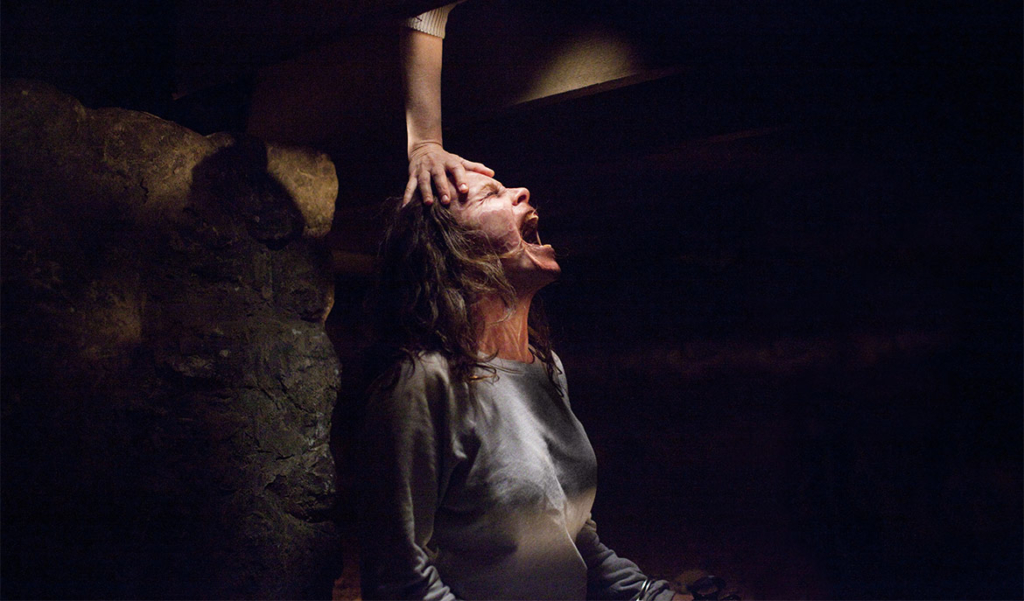
Classic vs Modern vs Post-Horror: Sam: Isn’t the fact that horror films have abandoned jump scares and gore a positive thing? Now they can appeal to a wider audience as there is less there to immediately turn them off. Those who enjoy traditional horror films however may turned off because they’re not “scared” in the typical sense anymore. The emotion that horror elicits doesn’t have to be extreme, it can be a feeling of repulsion or foreboding; a heightened sense of alertness that manifests physically. The general public is turned off because they’re not getting what they’re seeking from these movies; the adrenaline rush of being frightened. Maybe they just don’t want to be horrified in the way that these A24 films are attempting to deliver on. Aoife: I don’t think that’s the case, genre fans who are au fait with pre-Blumhouse horror would be much more forgiving of ‘post-horror style’ scares. The general public though, perhaps. Those people who don’t actively seek out horror (like us weirdos) and only go to see the movies everyone is talking about because they expect to jump out of their seats with fright? No one can blame those guys for being annoyed when they’re presented with the likes of It Comes at Night. The slow-paced building of tension with muted release must be maddening to them, especially when you compare the film with the trailer. Jamie: I’m not sure that these films abandoning jump scares necessarily equates to them being more palatable to a wider audience. I think people who are actively turned-off by jump scares tend to have a dislike towards the grim and macabre in film generally – I’m not sure the likes of The Witch or Hereditary would tick the enjoyment boxes for these people as they maintain those disturbing elements which many people look to avoid. On top of that, the arthouse approach, slow pace and lack of jump scares eliminates another demographic of moviegoers who are hoping to see a horror film specifically to experience exactly that. The only wider audience I feel these movies could resonate with who may not enjoy ‘traditional’ horrors are genuine movie-buffs, people who have an appreciation for how the films are put together with regard to writing, cinematography, acting, atmosphere etc. Aoife: I agree with Jamie on that one, I can see film-buffs who might usually turn their noses up at horror enjoying these despite their prejudices. Sam: I have to agree with you there too Jamie, there’s no denying how well put together these films are. There has been mention however of It Comes At NIght being the kind of film all audiences are tired of as they’ve had enough of the “trapped in isolation during a zombie attack”, and though It Comes At Night certainly isn’t that film, it does appear to be at first glance. Deadline Hollywood states poor word-of-mouth is what kept viewings low. Jamie: Absolutely, that movie is obviously a far cry from a zombie apocalypse isolation movie but I think the pre-release marketing and the resulting word-of-mouth really hurt the viewership and reputation for the film, which is a shame. Sam: Speaking of marketing, maybe we should turn our attention back to the production company that started this whole conversation.
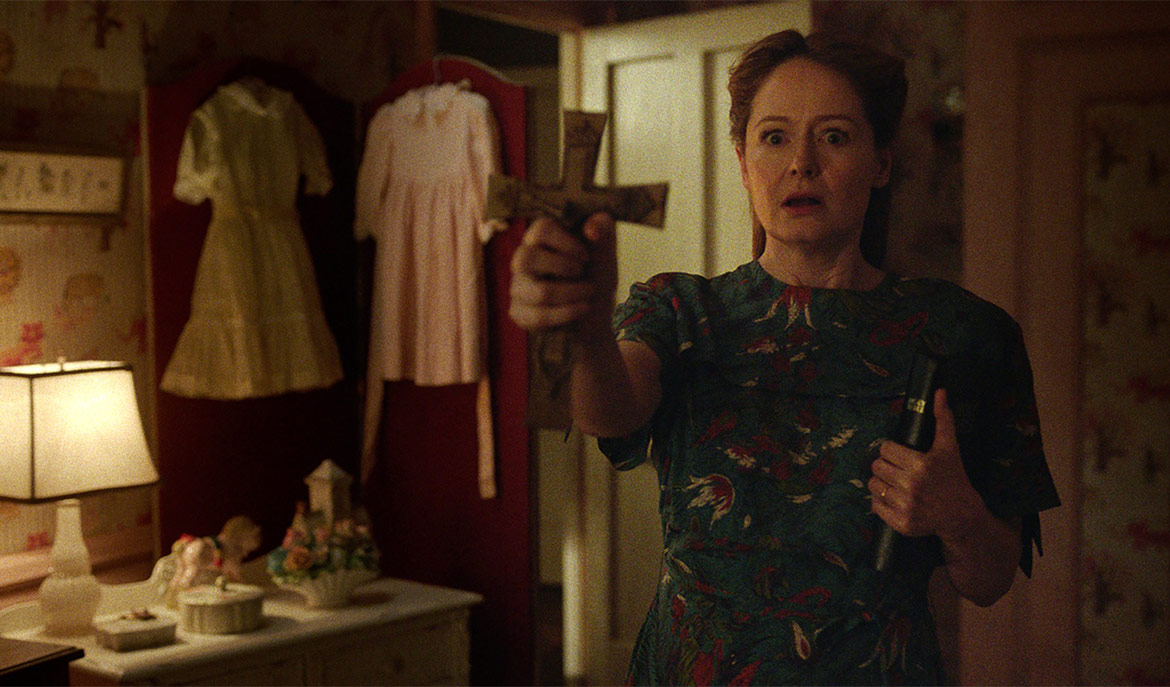
Audience vs Critical Reception: Jamie: Much has been made about the discrepancies between the critical reviews and the audience reaction when it comes to these select horror films in the A24 catalogue. What does this discrepancy look like, and what exactly do we think is the reason for it? Sam: There’s been a definite trend in the market to bring out films loaded with jump-scares, we’re already on the sixth film in the Conjuring universe with another two in the works and no sign of their profits slowing down. Audiences live for these types of films, they hear the tinkling opening notes and the dark hallway and know exactly what they’re in for. There’s going to be a ghost, generally a vengeful one, and a group of people who can’t escape its haunted grasp. This tried and tested plot has been in vogue for quite a while after audiences got tired of the shaky found-footage horror films á la Paranormal Activity. And I think therein lies the issue, if you ask the Average Joe what his favourite horror film is, how many people are going to answer “It Comes At Night”? Of course there are the die-hard horror fans who have a whole repertoire of films under their belt you’ve probably never heard of (I just learned about Basket Case the other day) but there aren’t enough of them to be heard over the scores of “That was the worst move I’ve ever seen” because it wasn’t the movie those people were expecting. Aoife: It’s worth noting that while these films polarised audiences, it would be drawing a false conclusion to assume that the more mainstream Blumhouse equivalents went down much easier. Paranormal Activity has an Audience Score on Rotten Tomatoes of 56%, Anabelle 36%, and The Purge 30%… Jamie: Aoife makes a good point, the only issue I’d raise is who we think the demographic of people logging in to Rotten Tomatoes to leave their little thinkpiece reviews are – a majority are very likely to be major film buffs. I think Cinemascore would make a more accurate reflection of initial audience reaction to films since you don’t have to log into Rotten Tomatoes to share your opinion, the scores are defined through ballot polling at the screening of the movies. Looking at those scores, Hereditary got a D+, It Comes at Night got a D, The Witch probably didn’t have a wide enough release as it doesn’t have a Cinemascore at all, Mother! got an F…In contrast Annabelle got a B rating here, so did Paranormal Activity 2, Insidious 3 has a B+, etc. I feel as though the audience who is bringing in the $143 million box office for Paranormal Activity 4 (nearly twice Hereditary’s box office, which remains A24’s highest grossing film) are generally teenagers looking for a quick spook, and if that’s what they get they will likely rave about the movie regardless of any critical scrutiny. Aoife: Cinemascores are notoriously tough on horror films, between 1986 and 2017 nineteen films got an F and of those nineteen, more than half are horror movies, though I concede that all those Blumhouse releases you mention Jamie have pretty excellent scores. That makes me wonder are we looking at this all the wrong way, it’s not that A24 have a ‘je ne sais quois’ that leaves critics enamoured and audiences bored, and it’s not that they’re necessarily doing anything all that groundbreaking, but it’s that Blumhouse have identified an X-Factor and know how to exploit it? Jamie: I definitely think Blumhouse have nailed a formula in terms of churning out horror films that follow very similar plot-points and scare tactics. But for the most part they remain critically panned and still mainly appeal to one specific demographic, and it seems to me that the formula may be starting to fail them somewhat as A24 continue to gain traction and find success with this new breed of horror that seems to go against the grain with regard to the path Blumhouse have laid out. Sam: I think we need to talk about A24’s marketing techniques as part of this discussion too. You ask anyone who went to see Hereditary if it’s the film they expected from watching the trailer and if they say yes they’re lying. All of their horror films are like this, and it’s both a blessing and a curse. It means for an audience member you’re going in blind, never getting what you expected, but for many this is exactly what turns them off. They wanted a scary film where they’re clutching their popcorn or laughing at the reactions of everyone around them. They’re looking for the adrenaline rush of being truly frightened, heart quickened and spending the walk home glancing over their shoulder… Jamie: I completely agree, the marketing of these movies is a crucial talking point for this discussion around reaction discrepancies. Arguably every horror film trailer A24 has released so far has been selling false promises, implying that these movies could be viewed in the same vein as films like IT, The Conjuring, Insidious, and so on. Inevitably this leads to disappointment on the part of people who go into these movies looking to destroy their armrests and jump out of their seats for the majority of the movie – multiple people I’ve spoken to personally have described movies like Hereditary or It Comes At Night as “boring”. But on the flip-side, would Hereditary have made nearly $80 million at the box office if it was marketed as the film it actually is, i.e. a slow-paced family drama with some horror elements and a gut-wrenching atmosphere that can make you feel physically ill? It’s a catch 22 for me, because on the downside you run the risk of disappointing a large percentage of your audience, but on a positive note you rake in enough money to fund that next risky project.
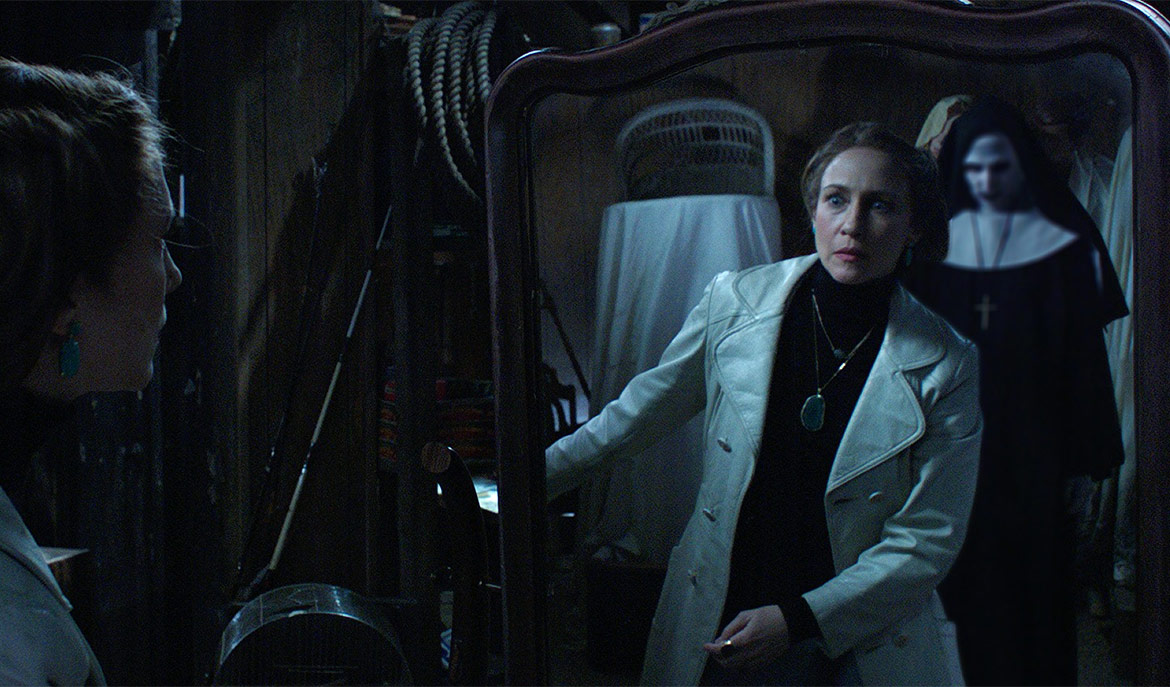
Looking at A24’s recent horror film output, and at how much we have managed to both agree and disagree with one another in the space of one conversation, the conclusion can be reached that art is, simply, subjective. The idea of post-horror as a genre seems to both fit and not depending on how you interpret the film, which though they are certainly influenced by classic horror films, stand alone in current cinema. It can be agreed however that these new style of films, whether post-horror or not, are certainly contributing to a revival of the genre.
Inflight Dublin launches wireless IFE for Saudi’s flynas
Inflight Dublin, a leading IFE provider, has launched Everhub (Inflight Dublin’s end-to-end wireless IFE system) across the full flynas fleet, as part of a 2-year contract with the Saudi carrier. flynas is the leading low-cost carrier in Saudi Arabia and has a fleet of 30 aircraft, operating over 1,000 scheduled flights every week. The airline flies to 17 destinations within Saudi Arabia and 53 international destinations. Our collaboration with flynas aims to significantly enhance the airline’s passenger experience through innovative technology trends, resulting in a robust, yet easy to install IFE solution. The new agreement supports flynas’ dedication to elevating passenger experience to the new heights. flynas passengers can enjoy movies, TV shows, music and podcasts, games, publications, a real time moving map, and the ability to provide feedback via a passenger survey. The system is currently offered in Arabic and English languages and can be simply accessed through a web browser using a phone, tablet or laptop.
flynas has the exclusive rights for use of the system in Kingdom of Saudi Arabia, and were thrilled with the speedy rollout (project took less than 4 weeks from contract stage to delivery of the first servers).
Everhub wireless system is a one-stop shop for all things IFE. Consisting of certified hardware, a versatile control centre and user-friendly front-end software. Each box can deliver over 12 hours of streamed video content. Inflight Dublin Chief Executive Officer, John White, further adds: “We’re delighted to be extending our wireless footprint into the MEA region. flynas is one of the leading LCC in the whole region and it makes us proud to be a part of their long-term passengers’ commitment.”

What’s Going On Board in September?
The first of the month is always an important day for us here at Inflight Dublin, as it’s when our clients’ inflight entertainment systems are updated with a selection of brand new content.
It’s the day when all those meticulously researched and lovingly curated films go from being an entry on a computer screen, to something that can be tangibly watched and enjoyed by a passenger. It mightn’t seem like much, but for us, it’s pretty exciting!
So, with a new month just around the corner, we’d thought we’d compile a list of just some of the fantastic films that will be going on-board as part of the September update.
And quite an update it is – we’ve got everything from action blockbusters to underground indie films to Bollywood epics, and much more besides.
Happy watching.
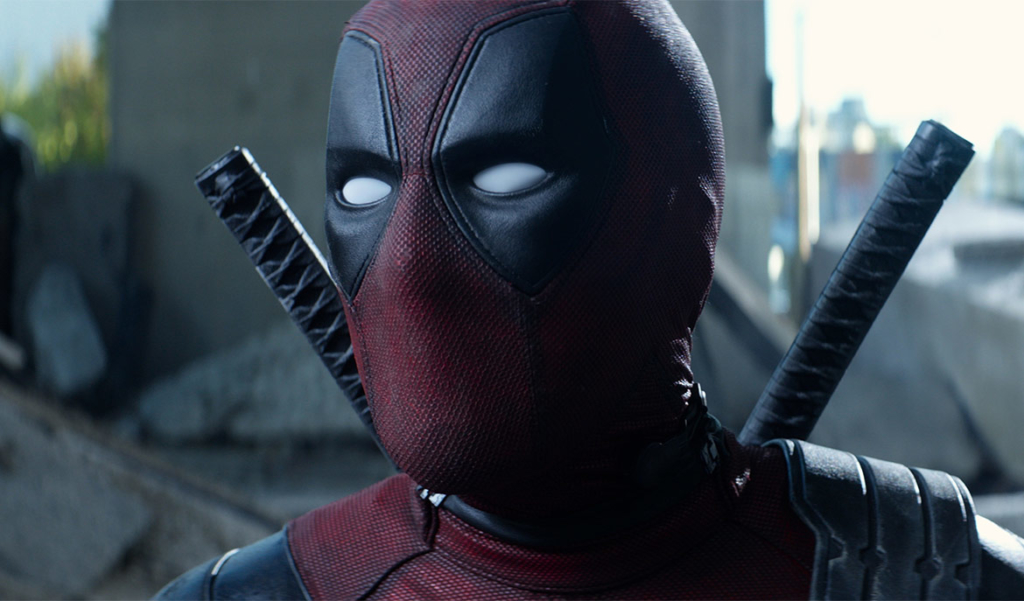
Deadpool 2
With its unique blend of sharp humour, postmodern narrative techniques and visceral action, Deadpool helped revitalise the superhero genre in 2016.
Deadpool 2 doesn’t deviate too much from the formula, but ramps it up, Spinal Tap-style, to eleven, and the result is the rare case of a sequel that’s an improvement on an already great first instalment.
The narrative centres on Ryan Reynold’s masked vigilante and his attempts to protect a young boy, who has supernatural abilities, from a time-traveling antagonist, Cable (played with suitable menace by Josh Brolin).
A critical and box office hit, passengers will love it. As long as they’re over 18. 😉
Tully
Charlize Theron stars as Marlo, a New York suburbanite who’s just given birth to her third son. Approaching breaking point due to the demands of motherhood, her wealthy brother hires Tully, a night-time nanny to help Marlo cope. Fraught at first, the relationship between mother and nanny soon develops into something special.
Tully is about a much overlooked topic in cinema – motherhood. Handling a tricky subject with humour and empathy, director Jason Reitman delivers a fantastic film that, propelled by Theron’s warm, heartfelt performance, is as moving as it is funny. A lovely watch and a perfect airline film.
American Animals
“One of the summer’s freshest, most entertaining films” according to Kenneth Turan of the L.A Times, American Animals is a heist film, but not the sort you’ve seen before.
Starring newcomers Evan Peters, Ann Dowd, Barry Keoghan, and Blake Jenner, the film follows four young Kentuckians and their plans to steal the rarest and most valuable books in their school library.
Subverting the genres’ clichés and hallmarks for something altogether more unique and fresh, passengers will love the film’s taut, slick storytelling and surprisingly philosophical, thought-provoking undercurrent.
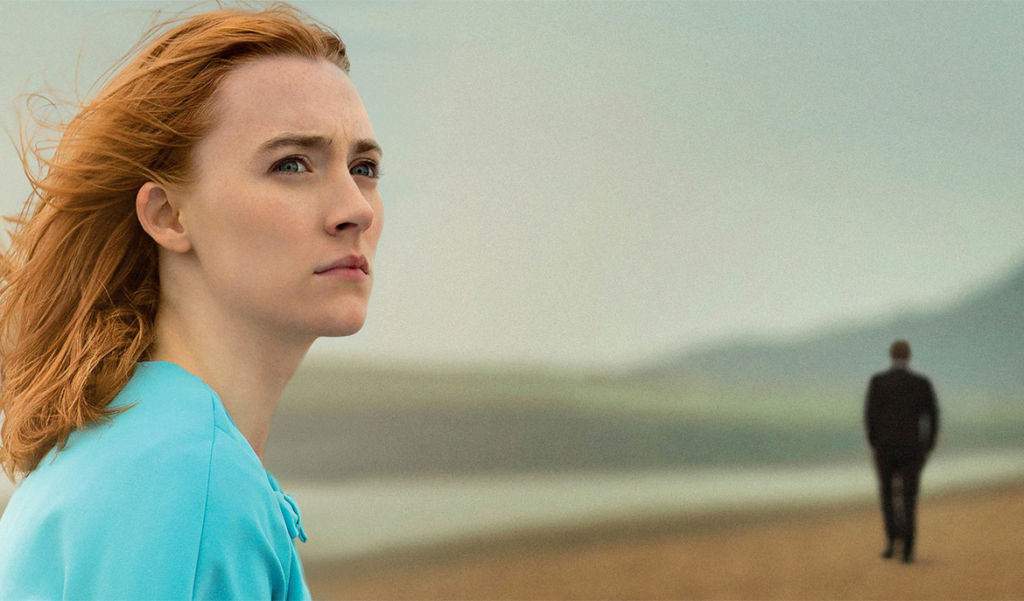
On Chesil Beach
Thanks to pitch-perfect performances in Brooklyn and Lady Bird, Saoirse (that’s pronounced “Ser-Sha”) Ronan has quite rightly established herself as one of the leading actors of her generation, and she returns in On Chesil Beach, a film about the societal pressures in 60s England that threaten to derail an idyllic romance between a young couple.
As is to be expected, Ronan, who stars as Florence, is fantastic, delivering a performance that’s layered with humour and pathos, but Billy Howle, who stars opposite, more than holds his own too.
Established icons of British cinema, such as Emily Watson and Emily-Marie Duff, make up the wider support cast of this rich and engaging film.
Ready Player One
Steven Spielberg returns to the directing chair for the 34th time (yes, you read the correctly – the 34th time) with Ready Player One, a sci-fi adventure adapted from the multi-award winning novel of the same name.
Set in a stunningly realised virtual reality universe called OASIS, it follows Wade Watts (Tye Sheridan) and his attempts to unlock the secrets of the mysterious world and those of its creator, James Halliday.
By blending old school Speilberg-isms with a modern visual style and contemporary cultural touchpoints, the director has created a bold film that is a worthy addition to his otherworldly canon. A must-see for any fans of the director, sci-fi, or just, well, really good movies.
White Fang
Based on the 1906 novel of the same name, White Fang is a timeless adventure about a wolfdog and his coming-of-age that has been loved by generations of children and adults alike.
It has been adapted for the small and big screen before, but never quite like this – animated in a lovely 3D style that is almost like a visual painting, and starring some top-end voice-acting talent (Nick Offerman, Rashida Jones and Paul Giamatti, to name but a few), this is its finest incarnation yet.
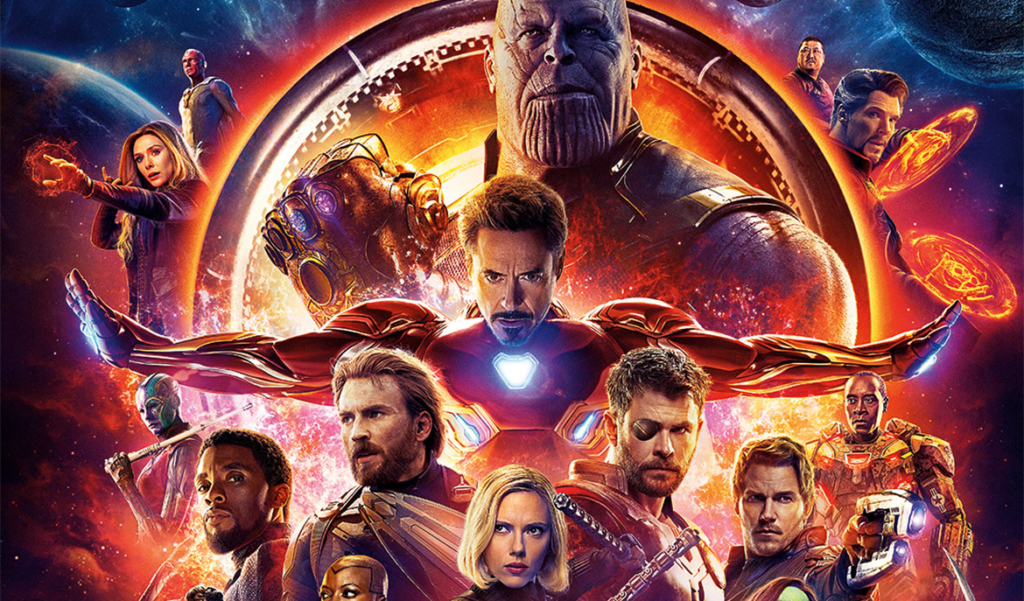
Avengers: Infinity War
Our favourite Marvel superheroes return in Avengers: Infinity War, where they must put aside their differences and team up to defeat the all-powerful, universe-destroying Thanos.
With its all-star cast, sharp, snappy script, engrossing narrative and mind melting action sequences, the film far transcends the massive expectation that preceded its release.
A success both with the critics and at the box office, it’s a blockbuster in the truest sense of the word.
Life Of the Party
Who doesn’t love Melissa McCarthy? From her iconic role as Sookie in Gilmore Girls to taking the lead in global superhits like Spy and The Heat, her loveable presence and instinctive, deft comedic touch lights up the screen.
Life of the Party sees her star as Deanna, a suburban housewife who decides to return to college and kick her life into gear following a painful divorce.
Much partying and hilarity ensues as she embraces her new lifestyle, however it’s to the horror of her daughter Maddie, who just so happens to attend the same school. Eek.
Belle et Sébastien 3, le dernier chapitre
The concluding chapter to the much loved French series about a child named Sébastien and his beloved dog Belle, Belle et Sébastien 3, le dernier chapitre is a heartwarming tale of family, love and loyalty.
In this third instalment we are introduced to the menacing Joseph (played by Clovis Cornillac who you may recognise from 2004 classic Un long dimanche de fiançailles) who claims he used to own Belle and will do whatever it takes to reclaim the Pyrenean mountain dog. Sébastien however, has other ideas.
A visually impressive film packed with snow-capped mountains and grand vistas, Belle et Sébastien 3, le dernier chapitre is a classic good-versus-evil tale that will be loved by the younger passengers on-board.
Rampage
Dwayne Johnson, a.k.a The Rock, brings his signature blend of charm, brawn and humour back to our backseat screens in Brad Peyton’s exhilarating Rampage.
Starring as Davis Okoye, Johnson plays a primatologist who has forged a special bond with George, an exceptionally intelligent silverback gorilla. When the latter becomes infected with a dangerous pathogen, he transforms into a city-destroying predator and up to Davis, and geneticist Kate Caldwell (brilliant played by Naomie Harris), to both save humanity, and the animal that was once his friend.
Solo: A Star Wars Story
Empire magazine curated a list of the greatest Star Wars characters for their August 2018 issue, and you may be curious to know who came in at numero uno – well, it was, of course, everyone’s favourite deep space outlaw, Han Solo.
This much-loved character takes centrestage in Solo: A Star Wars Story, a long awaited prequel that explores the history of the loveable rogue, aswell as the wider Star Wars universe.
Portrayed with just the right amount of brazen charm and cheeky arrogance by Aidan Ehrenceich, the film lives up to its high billing with a sharp script, blistering action sequences and a host of great characters, some of whom longtime fans will undoubtedly recognise.
The Monkey King 3
The third film in the massively popular Chinese franchise sees Aaron Kwok, Feng Shaofeng, Xiao Shenyang and Him Law once again join forces to continue their “Journey to the West” – this time entering a kingdom populated exclusively by woman.
A swashbuckling rollercoaster of a film, The Monkey King 3 is a well-told tale in the classic storytelling tradition that blends fantastic visuals and hilarious comedy. The numbers can speak for themselves, though – since its release, it’s become the fifth highest grossing Chinese film in 2018, raking in over $115 million at the international box office.
Baahubali 2: The Conclusion
A three hour extravaganza of colour and song, Baahubali 2: The Conclusion is a fantasy and adventure epic that drew record numbers worldwide – it currently stands as the first ever film to gross over ₹10 billion, doing so in just ten days.
Taking off from where its predecessor, Baahubali: The Beginning, concluded, this second instalment centres around Amarendra Baahubali, a heroic leader who makes, as Simon Abrams wrote in his five star review for RogerEbert.com, “Conan the Barbarian look like a wimp”.
An exciting and surprisingly complex film, Baahubali 2: The Conclusion is a visual feast, and a must-see for any fan of Indian cinema.
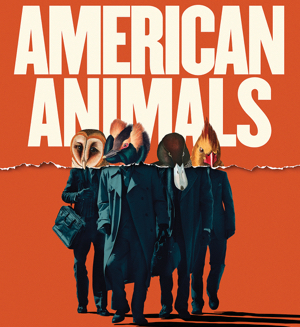


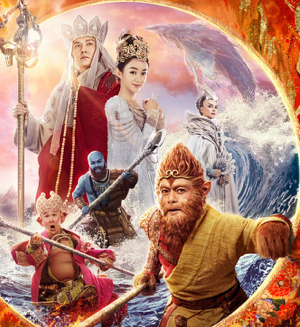
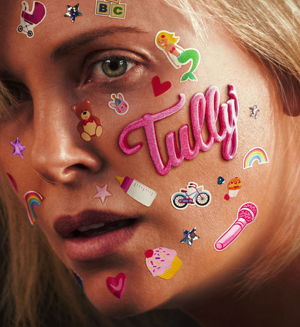



Accounting for Taste: Differences in Genre Popularity Across the World
I recently came across an article called “The Relative Popularity of Genres Around the World” by Stephen Follows and Bruce Nash.
About how liked (or disliked) certain genres are in different countries, it’s a fascinating piece of research.
I thought it’d be a good idea to take a look at their findings.
Let’s dive in.
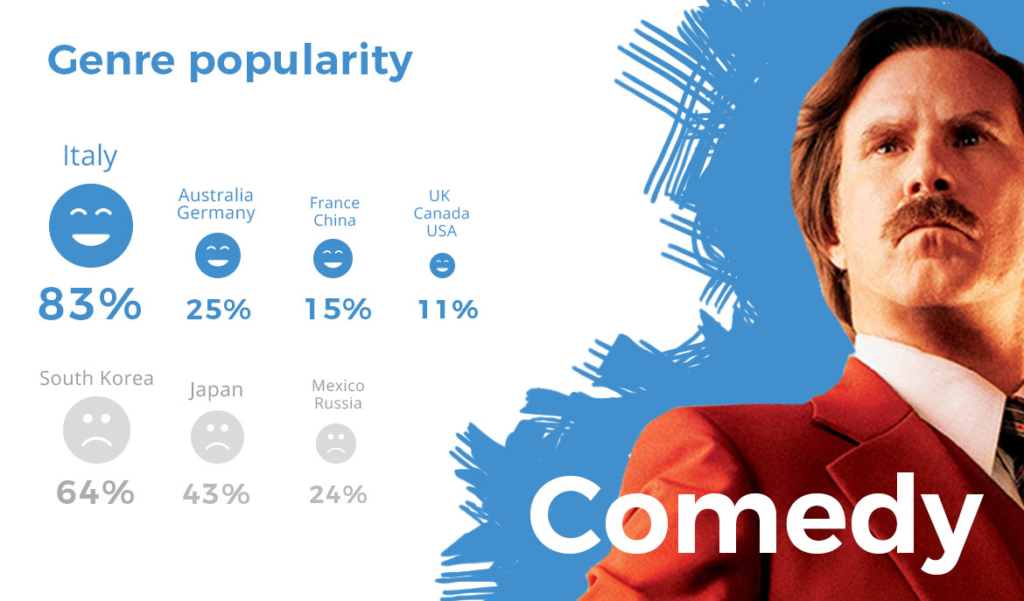
If we take 0% as the global average of a genre’s popularity, we can see, with a rating of 83%, that Italy really loves comedy movies.
I wasn’t surprised to see this. This is, after all, the country that gave us its very own comedy subgenre: commedia all’italiana (or “Comedy the Italian Way”).
At the opposite end, with a score of 64% below the global average, is South Korea.
South Koreans, generally speaking, like the genre to be part of a blend in their films. Parasite, for instance: a movie that’s as much a comedy as it is a thriller and drama.
So it mightn’t be a case that they dislike it, but rather prefer comedy to be another colour in an eclectic mix.
Let’s take a look at action movies.
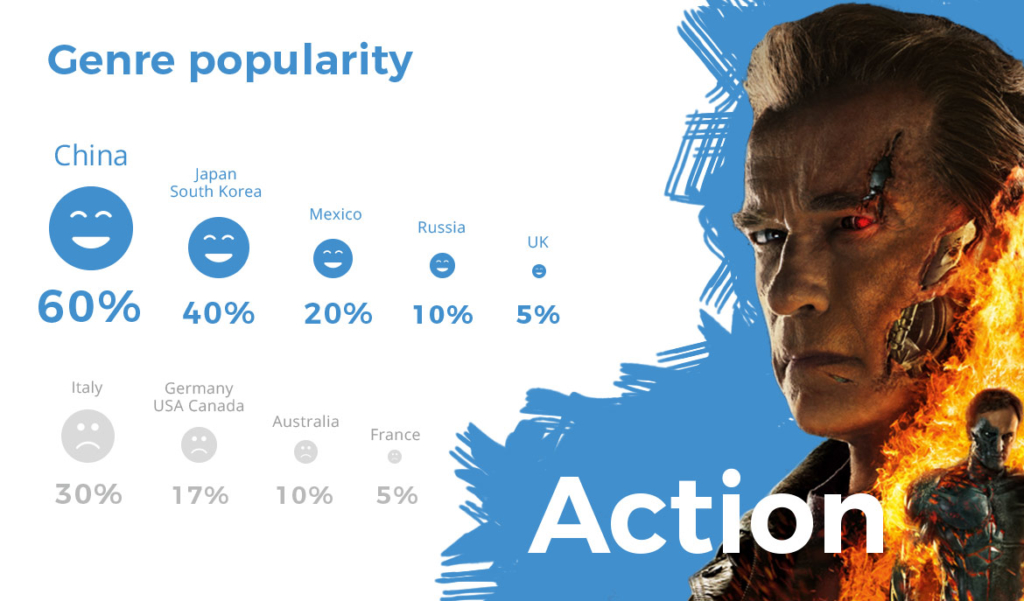
This is an interesting one.
Whereas Italians are the world’s great lovers of comedy, with a score of 30% below, they’re not too fond of action.
South Korea, who weren’t keen on comedy, love it as much as the Italians don’t: they have a high rating of 40%. The two countries have the opposite taste in films!
The birthplace of Kung Fu, Crouching Tiger Hidden Dragon, Jackie Chan and Bruce Lee, it’s not surprising that China tops the list.
However, for a country that gave us Bruce Willis, Sly Stallone and Chuck Norris, North America’s rating of 17% below is very surprising indeed.
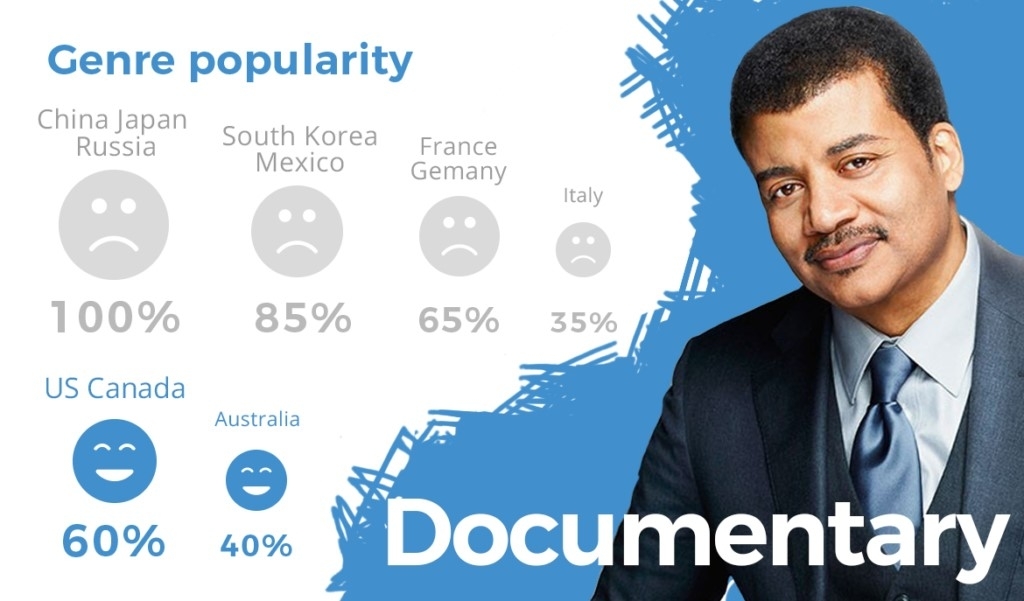
Documentaries are huge in the US and Canada. Given the ubiquity of brands like National Geographic and Discovery, as well as names like Neil deGrasse Tyson, this isn’t unexpected.
The two countries have produced some excellent feature-lengths recently – Apollo 11, RBG, American Factory and Free Solo to name a few – and this has established them as leaders in documentary filmmaking.
There’s a correlation across the three Asian countries (South Korea, Japan and China). They all score well below the global average.
But this doesn’t mean that they don’t produce documentaries, and good ones too: Jiro Dreams of Sushi is one of my perfonal faves, and Last Train Home, Old Partner and Up the Yangtze are worth checking out too.

Remember what I wrote about South Korea and Italy having opposing tastes? Well, hold that thought. Because, with scores of 50% and 40% respectively, both countries find common ground in a love of drama.
But the most curious stat here is the UK.
Much like how I was taken aback by the US’ lack of love for action, I was surprised by the UK’s rating for drama.
This is the country that gave us everything from Shakespeare to Austen to The Crown; surely there has to be a greater appreciation than 2% below?
I would wager that if plays, novels and TV were included, we’d see the UK at the top of this one. Perhaps that’s a study for another time!

Considering their lack of love for comedies (24% below), it’s interesting that Russians like the genre a lot more when there’s some romance thrown in.
I wasn’t surprised when I saw this, though.
I recently researched the Russian market and it struck me that, along with action and historical films, the country produces a lot of rom-coms.
Status Free, Ice 2, Imperfect Man and How I Became Russian come to mind; cheerful, easygoing crowd-pleasers that packed Russian cinemas.
Mexico leads the way with a score of 18% above.
Recent romance-tinged Hollywood blockbusters, like The Shape of Water and Fifty Shades Freed, did well here. Both went to number one at the domestic box office, and accrued higher grosses in Mexico than in similarly-sized territories.
The country has a healthy market for homegrown romances too; Tod@s caen with a gross of $136 million, was 2019’s best performing Mexican language film.

Mexican cinemagoers are an open-minded bunch; not only do they love romance, but horror movies too.
This is what critic Justina Bonilla had to say about the country’s ties to the genre (I recommend reading the original article here):
On the flipside of the coin, the genre dies a gruesome death in China where we see the highest disapproval rating yet: 100% below the global average. Roger Garcia, executive director of the Hong Kong film festival, gave his take in this 2016 interview:
Conclusion
Follows and Nashs’ figures aren’t an exact science, and there will always be exceptions. Action films that do well in Italy for instance, or horrors that fall flat in Mexico.
Nevertheless, there’s no doubting that it’s an important and insightful piece of cinematic research.
The findings show us, not just the specific likes and dislikes of a given country, but how changeable and fluid genre popularity is; depending on the territory and culture, you can have wildly different results.
To each their own, I guess!
At Inflight Dublin, we pride ourselves on providing the highest quality film, TV and audio content to our clients. If you’d like to learn how we can do the same for your airline, get in touch. Connect with us here.
Image Credits
- Images created by Inflight Dublin, based on the research by Stephen Follows and Bruce Nash of the American Film Market.
Further Reading
- “The Relative Popularity of Genres Around the World” by Stephen Follows and Bruce Nash.
- “Why Scary Chinese Movies Are So Scarce” by Li Anlan.
- “15 Movies to Get You Started With Mexican Horror” by Carlos Aguilar.
- “The Era of Italian Comedy” by Ancos.
- “The Top-Rated Movie in Every Country” by Emily Petsko.




